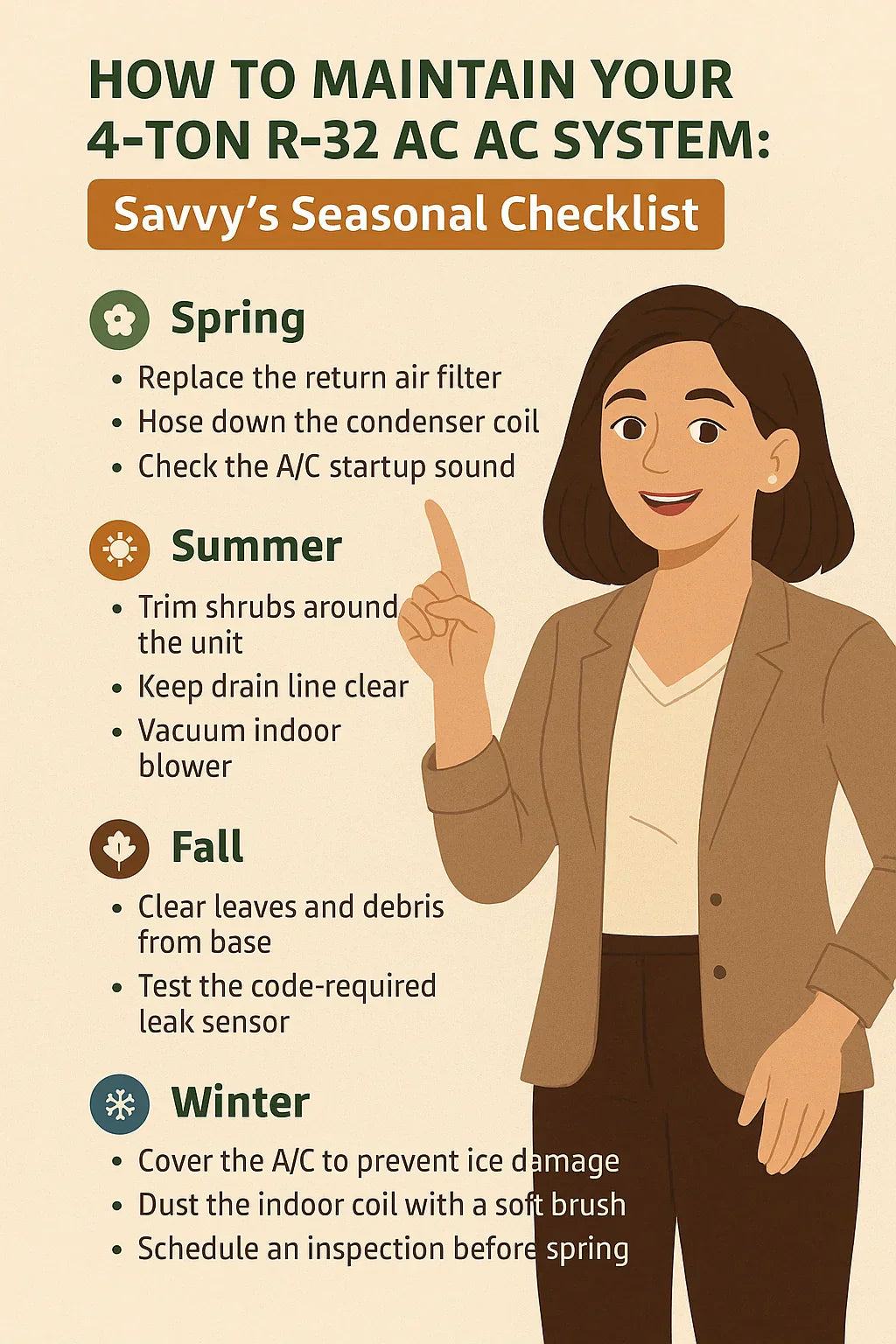If you’ve invested in a 4-ton R-32 air conditioner, you're already ahead of the curve on eco-friendly cooling. But even the best equipment needs seasonal attention to keep efficiency high and repair bills low. Meet Savvy — a homeowner who created a smart seasonal checklist that keeps her 4-ton R-32 AC running like new, year after year. Whether you’re a DIYer or plan to tag in the pros, this guide will walk you through everything you should do, from spring prep to winter shutdown.
🌸 Spring: Prep Before the Heat Hits
Goal: Get your system ready before summer puts it to the test.
1. Replace or Clean Filters
-
Use high-efficiency pleated filters compatible with your R-32 system.
-
Clean reusable filters with mild detergent and water.
-
Frequency: Every 1–3 months, depending on dust and pets.
2. Inspect Indoor Air Handler
-
Remove front panels and vacuum any visible dust.
-
Look for condensation, mold, or signs of leaks.
-
Check for secure electrical connections.
3. Clean Outdoor Condenser Unit
-
Power off system at the breaker.
-
Gently rinse coils and fins with a garden hose (never use high pressure).
-
Use a coil cleaner for stubborn dirt (R-32 safe only).
-
Trim vegetation within 2 feet of unit.
4. Check the Drain Line
-
Locate the PVC condensate drain line and flush it with vinegar or bleach.
-
Use a wet/dry vac if there’s a clog.
5. Test the Thermostat
-
Upgrade to a smart thermostat if you haven’t.
-
Confirm summer settings, and test auto mode.
-
Replace batteries if applicable.
6. Schedule a Pro Tune-Up (Optional)
-
Ask for a refrigerant pressure check and ensure R-32 charge is optimal.
-
Have your HVAC tech inspect the expansion valve and blower motor.
🌞 Summer: Monitor Performance Under Load
Goal: Keep airflow strong and efficiency up.
1. Monthly Filter Checks
-
High use in hot months can clog filters fast.
-
Swap out as needed to keep airflow strong.
2. Check for Icing or Short Cycling
-
Frost on the evaporator coil or outdoor unit could mean airflow or refrigerant issues.
-
Short cycling (frequent on/off) may mean the system is oversized or dirty.
3. Listen for Strange Sounds
-
Rattling = loose parts.
-
Hissing = refrigerant leaks.
-
Buzzing = capacitor or contactor failure.
4. Track Energy Bills
-
A spike in kWh could mean clogged filters, low refrigerant, or duct leaks.
🌿 Fall: Prepare for Cooler Months
Goal: Wind down cooling season and prep for potential heating use.
1. Deep Clean Indoor Components
-
Use a coil brush and safe cleaner on indoor evaporator coils.
-
Vacuum blower wheel and motor housing if accessible.
2. Inspect Ductwork
-
Check for visible cracks or loose joints.
-
Reseal with HVAC foil tape or mastic.
3. Check System Insulation
-
Inspect refrigerant line insulation for cracking or peeling.
-
Replace with closed-cell foam sleeves.
4. Cover Outdoor Unit (Optional)
-
Use a breathable AC cover to protect from leaves and debris — never wrap in plastic.
❄️ Winter: Shut Down and Protect
Goal: Prevent damage during freezing temperatures.
1. Power Down System if Not in Use
-
Switch off at the outdoor disconnect.
-
Prevents accidental startup during cold spells.
2. Inspect for Ice Buildup or Rodents
-
After snowstorms, check for icing on the condenser.
-
Ensure no critters have nested in or chewed wiring.
3. Maintain Smart Thermostat Settings
-
Program for away mode to save energy.
-
If heat pump mode is used, ensure backup heat kicks in smoothly.
4. Schedule Off-Season Service
-
Winter is a great time for discounted maintenance appointments.
-
Pros can check refrigerant charge and compressor health while usage is low.
📄 Bonus: Annual Maintenance Record Sheet
Create a simple log to track:
-
Filter changes
-
Pro tune-up dates
-
Issues found (leaks, odd noises, etc.)
-
Component replacements
This will help with:
-
Warranty claims
-
Troubleshooting patterns
-
Home resale value
🧣 Savvy’s Final Advice
“Even the most efficient 4-ton R-32 system will wear down without attention. A seasonal checklist doesn’t just prevent repairs — it protects your investment and the environment.” — Savvy
By staying consistent with maintenance, you can stretch the lifespan of your system, lower your energy bills, and enjoy cleaner indoor air all year long. Don’t wait for something to break — build your seasonal habit today.
🔗 Related Reading
-
Installing a 4-Ton R-32 System: What Savvy Did Before Calling a Pro
-
How Efficient Are 4-Ton R-32 Systems? Understanding SEER2, EER & Real Savings
💡Pro Tip:
Many manufacturers require proof of maintenance to honor your warranty. Print this checklist or digitize it using a home maintenance app to stay compliant.
In the next topic we will know more about: Do R-32 Systems Qualify for 2025 Energy Tax Credits? What Savvy Found Out About Savings, Rebates & Requirements







